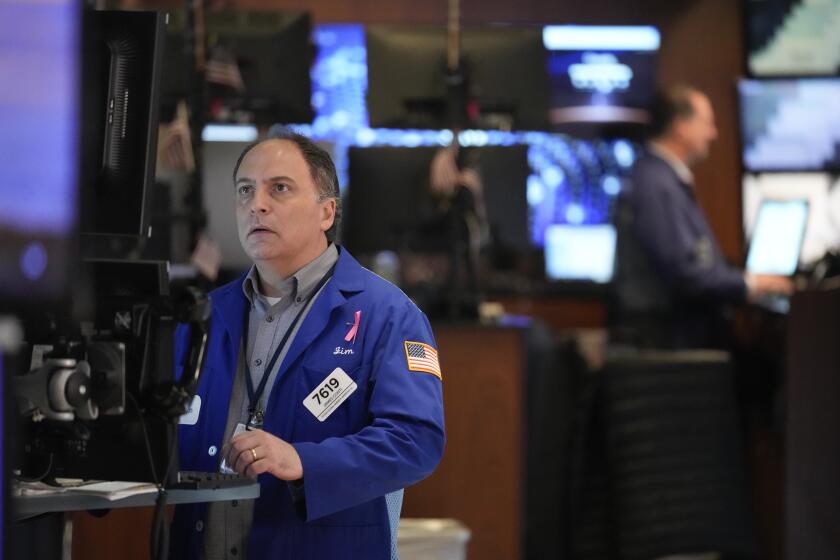Insurance Option Has Workers Pay More
For years, they were the kinds of health insurance plans one found at small businesses or among the self-employed, plans that had huge deductibles and required workers to pay a lot of medical bills themselves -- such as allergy shots, chest X-rays and the cost of a new baby.
They weren’t the policies most people preferred, but they were the best some people could afford, better than no insurance at all.
Now, as medical costs keep climbing, those high-deductible plans are spreading to the giant corporations that have long been the backbone of traditional job-related, low-deductible health insurance. And if the trend continues, it could reshape the medical insurance landscape and sharply redistribute costs, risks and responsibilities for many of the 160 million Americans with private coverage.
A number of large employers, including defense contractor Northrop Grumman Corp., the Wendy’s hamburger chain, high-tech conglomerate Fujitsu and office supply retailer Staples Inc., are adding what they call consumer-directed health plans to their menus of insurance options.
In a recent survey, 26% of large employers said they would offer such plans in 2006, up from 14% this year. Another survey found that about half of large companies were considering adding them.
A few companies are pursuing a “full replacement” strategy that leaves workers with no other choice. But even where such plans are optional, they are proving popular with workers who might once have scorned a plan that could leave them with several thousand dollars in medical bills each year. At Fujitsu, about half of 5,000 eligible U.S. employees have signed up for the option.
What suddenly makes such plans attractive to workers is that many are caught in a painful bind: In recent years, pay increases have been small at best. At the same time, employers have been requiring workers to pay a larger and larger share of their health insurance premiums. It’s not uncommon for higher payroll deductions for healthcare to more than offset any pay raises.
With the high-deductible plan, workers pay lower monthly premiums and their employers commonly help them build up a special savings account to cushion the impact of a larger annual deductible. The accounts are controlled by the employees, which has led insurers and employers to label the plans “consumer-directed.”
Even if high-deductible plans offer immediate relief for many workers, and big cost savings to employers, the allure may not last. And the plans may do little or nothing to solve the basic problem of soaring health costs.
“You’re beginning to see a lot of growth in these plans, not because they’re going to solve America’s healthcare challenge, but because it’s a way for employers to cut their out-of-control benefit costs,” said Robert Laszewski, a consultant to health insurance companies. “Any time an employer can raise deductibles from $200 to $1,000, it is going to reduce their costs. But will it reduce U.S. health costs generally? The jury is still really out on that.”
The reason, he said, is that 10% of the people -- the sickest Americans -- account for 70% of total healthcare costs. “Once the sick people have gone through their deductible, they’re back to a regular health plan -- the incentives for them don’t really change,” Laszewski said.
“This is a cost shift device, and not a means to fundamentally control healthcare costs.”
Moreover, the willingness of workers to sign up for less generous plans may change over time, as workers and their families get older and more likely to encounter serious medical costs.
“To make these plans truly work, they have to work for the sickest population -- it can’t be a plan that only works for the healthy,” said Joe Walshe, a principal with the consulting firm PricewaterhouseCoopers. “It’s very difficult, but that’s where the challenge is.”
In the meantime, the short-term appeal of high-deductible plans is easy to see. Employees get a bit more take-home pay. Employers get some relief from higher healthcare costs.
For big companies, the new plans represent an upfront savings of about 10% and the expectation of more gradual cost increases over time. Last year, large employers spent an average of $5,584 per worker for coverage through a high-deductible plan, compared with $6,181 for a worker in the typical preferred provider network, according to a Mercer Human Resource Consulting survey.
Employers say the new plans are not designed primarily to shift costs to workers. The ultimate goal, they say, is to cut healthcare costs by changing consumers’ behavior -- teaching them to be more cost-conscious about things such as generic drugs.
“In three to five years, every company is going to offer them,” predicted Alexander Domaszewicz, a Mercer senior consultant based in Newport Beach. “People are going to be coming over from companies that have them, and they are going to want them.”
When the city of Las Vegas began offering a consumer-directed plan to 2,200 eligible employees last year, 60% signed up.
“When I was growing up in the 1950s, no one had insurance for day-to-day going to the doctor,” said Victoria Robinson, the city’s insurance manager. “You covered those expenses yourself and had major medical if you had to have your appendix out or something like that.
“It’s almost like going back to the future,” she said.
Yes and no, analysts say.
When employers began offering health insurance, it was a way to attract workers by offering them something of value without directly raising their pay. Today, in purely economic terms, shifting insurance costs to workers amounts to reducing compensation.
Although workers may think they will only face the high deductible if serious illness strikes, those receiving routine medical care can also face fairly hefty medical bills.
Many of the new plans “confront people with a lot more cost sharing than they are currently experiencing,” said Sherry Glied, a health policy professor at Columbia University. “If you are the kind of person who can’t keep $2,000 in an account, it could be a really bad idea for you.”
The experience of Mark Pung, a general contractor in Grand Rapids, Mich., shows why such plans can be enticing.
The father of four children, Pung says he would never dream of going without health insurance. Yet he and his wife, Dana, paid for the births of their two youngest children out of their own pockets -- $3,600 for each healthy baby girl. That’s because their medical insurance carries a $5,000 deductible for the family.
Since their premiums are $180 a month, or $2,160 a year, they could find themselves with as much as $7,160 in out-of-pocket healthcare costs in a single year.
On the other hand, the Pungs face much lower monthly premiums than they would have to pay for a traditional plan: between $800 and $1,400 a month for family coverage -- at least $9,600 a year in premiums alone.
Initially, Pung said, “I felt more exposure. But it wasn’t enough to stop me from doing it, because I could run the numbers and see how much sense it made.”
The numbers would not be so dramatic for workers in company plans. Employers help pay premiums and the deductibles are lower. In 2004, the median deductible for a family in a company-provided plan was $3,000. The employer contributed $1,200 toward that through a special account, according to Mercer, leaving the employee responsible for $1,800.
Proponents of consumer-directed healthcare say another advantage of the plans is that higher deductibles encourage consumers to shop smarter.
The two major firms that administer the plans for large employers -- Lumenos Inc. in Alexandria, Va., and Definity Health Corp. in Minneapolis -- also supply employees with ideas for saving money, online healthcare information and related services.
“The key thing is the whole concept of getting the consumer engaged,” said Doug Kronenberg, chief strategy officer for Lumenos. “We’ve got to see behavior change for us as a country to be able to address the escalating healthcare costs we’ve got.”
When patients have no “skin in the game,” he said, they don’t think about how to save.
In Washington, Republican policy-makers have encouraged the trend toward high-deductible insurance plans.
Congress expanded tax-sheltered medical accounts and renamed them health savings accounts, or HSAs, in the 2003 Medicare prescription drug bill. A year earlier, the Treasury Department had quietly issued a ruling that enabled employers to offer a plan known as a health reimbursement arrangement.
The savings accounts are available to people who buy health coverage with deductibles of at least $1,000 for individuals and $2,000 for families. Employees and employers can make pretax contributions to cover the deductible. The accounts belong to employees, who can take them along when they switch jobs. With reimbursement accounts, employees don’t own the healthcare accounts. They can roll over unused balances at the end of the year, but they cannot take their accounts with them if they switch jobs.
In a typical reimbursement account, an employer would create an account for an employee and family, and commit to cover the first $2,000 of their healthcare costs. The employee would then be responsible for the next $1,000.
After that, traditional health coverage would kick in, with the policy paying 90% of the costs and the employee 10%. Both the reimbursement and savings accounts have caps on how much an individual can be required to pay in a year.
Still, financial incentives can change -- especially as individuals realize they need greater levels of healthcare.
“The real concern is that people will want to switch out of these plans when they get sick,” said Glied, the Columbia professor. “Then it will be very expensive for employers.”
*
*
(BEGIN TEXT OF INFOBOX)
New health plans
“Consumer-directed” health plans offer medical insurance with lower monthly premiums and higher annual deductibles. On average, they are less costly for large employers than are other kinds of health plans.
Average annual cost per worker
Consumer-directed plan: $5,584
Health maintenance organization (HMO): $6,003
Preferred provider plan: $6,181
Traditional indemnity: $6,383
--
Bottom Line for Employees
Workers with consumer-directed plans spend more before insurance takes over. Employers may contribute to accounts that can close the gap. Median employee deductibles and employer contributions:
Employee-only coverage
Deductible: $1,250
Employer contribution: $700
Family coverage
Deductible: $3,000
Employer contribution: $1,200
*
Source: Mercer Human Resource Consulting, 2004 Employer Health






